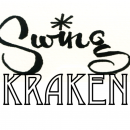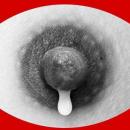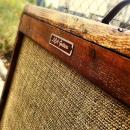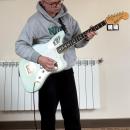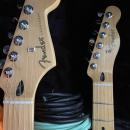Paco escribió:
Sacado del libro "Keeping the Flame Alive" de Walter Carter.
Whether it was rivalry between plants or increased market awareness, the Nashville plant jumped into the reissue action in 1980. By this time, one of the most glaring deficiencies of new Les Pauls (compared to the originals) was the humbucking pickup. In preparation for its first attempt at a reissue, Gibson assigned engineer Tim Shaw the job of designing a reissue of the original Patent-Applied-For humbucking pickupwithin certain restrictions. This was 1980 and Norlin was already feeling the pinch, Shaw said, referring to Gibson's long decline through the 1970s and early '80s. We weren't allowed to do much retooling. We redid the bobbin because it was worn out. We got some old bobbins and put the square hole back in. We did it without the T-hole, which stood for Treble.
To replicate the magnets, Shaw gathered up magnets from original PAFs and sent them to a lab to be analyzed. Most were Alnico 2's, he said, but some were 5's. In the process of making an Alnico 5, they stick a magnet in a huge coil for orientation, but an unoriented 5 sounds a lot like a 2. They started with Alinco 2 and then switched to Alnico 5.
Shaw discovered that the original magnets were a little thicker than 1980 production magnets. Magnetic strength is largely a function of the area of the polarized face; increasing the face size gives you more power, he explained. So he specified the thicker magnet for the new PAF.
Wiring on the originals was #42 gauge, which Gibson still used. However, the original wire had an enamel coating and the current wire had a polyurethane coat, which also was of a different thickness or buildup than that of the original, which affected capacitance. Norlin refused to go the extra mile-or extra buck, as it were. Enamel-coated wire cost a dollar more per pound than polycoated. Shaw could change the spec on the buildup without additional expense, so the thickness of the coating was the same as on the original wire, but he was forced to use the poly coat. The difference is easy to see: purple wire on the originals, orange on the reissues.
Shaw later found a spec for the number of turns on a spec sheet for a 1957 ES-175. It specified 5,000 turns because a P-90 had 10,000 turns and they cut it in half, Shaw said. In reality, however, originals had anywhere from 5,000 to 6,000 turns, depending on how tight the coil was wound. Shaw later met Seth Lover, who designed and patented Gibson's humbucker, at a NAMM show. Lover laughed when asked about a spec for windings, and he told Shaw, We wound them until they were full.
The spec for resistance was even less exact, Shaw said. The old ohmeter was graduated in increments of .5 (500 ohms). Anywhere between 3.5 and 4 on the meter (3,500 to 4,000 ohms) met the spec. Consequently, Shaw pointed out, there is no such thing as an exact reissue or replica of the 1959 PAF pickup. There can only be a replica of one original PAF, or an average PAF. As Gibson would find out in the early 1990s, the same could be said about the entire guitar.
Shaw's PAF reissue debuted on Gibson's new Nashville-made Les Paul Heritage 80 in 1980. Compared to anything Gibson had previously made (which is to say, compared to nothing), it was an excellent reissue of a sunburst Les Paul Standard. It had a nice top, thin binding in the cutaway, nickel-plated parts, more accurate sunburst finish and smaller headstock, but the body shape, body size and three-piece neck, among other details, were just regular production. It appears that Gibson still didn't understand the demand for an accurate reissue, because Gibson accompanied the Heritage 80 with fancier versions: the Heritage 80 Elite, with an ebony fingerboard that had no relevance to the reissue market (although it did have a one-piece neck) and the Heritage 80 Award, with gold plated hardware that also had no relevance to the reissue market.
me ha encantado!!
el alnico 5 que usaban es el unoriented, se utiliza mucho para tunear pastillas y buscar más un sonido T TOP que PAF. Por ejemplo, y comprobado por mi, unas 490 t y tuneadas con el unoriented alnico 5 o con el short alnico 5 cogen un tono muy parecido a las T TOP .
es muy gracioso también , y lo saco por los comentarios del "video" habla de la decadencia de Gibson en los 70 y 80.... era Norlin...que `por cierto son una guitarras cojonudas, ya me gustaría tener una con mastil de arce aunque tenga un cuerpo de sandwich.
Paco escribió:
A pesar de la bancarrota, la venta de guitarras iba bien, el problema ha sido comprar empresas raras por parte del CEO Henry Juszkiewicz.
menos mal que por fin se habla de los problemas financieros de Gibson por que no tienen nada que ver con la calidad actual que yo creo que es de las mejores epocas de calidad que han tenido.










